Relevance: GS Paper - III
News Excerpt:
According to the data comes from an analysis of satellite and balloon-based observations by the United States National Oceanic and Atmospheric Administration (NOAA) and National Aeronautics and Space Administration (NASA), the Antarctic ozone hole was deemed "modest," ranking 12th worldwide, however, there are indications of improvement.
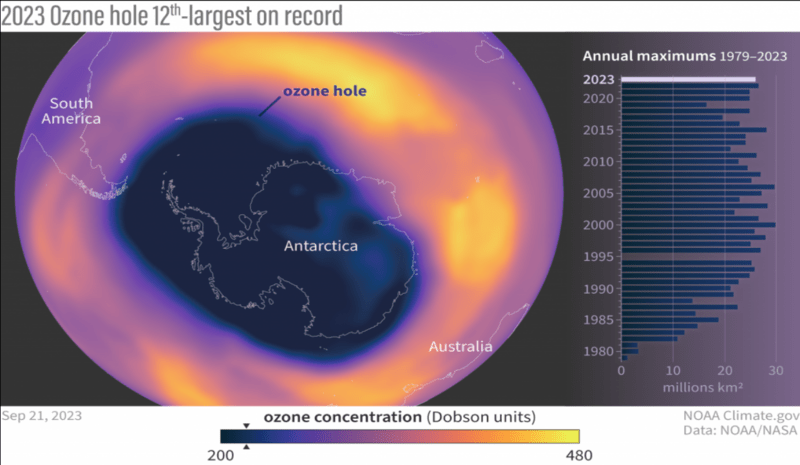
Key observation:
- The Antarctic Ozone Hole grew to be 10 million square miles at its largest on September 21, 2023.

- The origins of this depletion first reported in 1985, are rooted in chemical substances, particularly those containing chlorine and bromine, which ascend to the stratosphere and subsequently break down, initiating a chemical onslaught on ozone molecules.
- Among these are chlorofluorocarbons (CFCs), prevalent in numerous consumer products before their phase-out under international agreements.
- The annual maximum size of the hole in 2023 was the 12th largest since records began in 1979.
- This year, during the critical period between September 7 and October 13, when ozone depletion is most pronounced, the ozone hole remained on average at 8.9 million square miles. This expansive area mirrors the vast geographical footprint of North America.
- This year’s Ozone layer thinning measurements indicated a 95 percent thinning, inching perilously close to a 100 percent loss within the stratosphere.

- Paul Newman, at the helm of NASA’s ozone research team, noted a positive trend in the containment of the Antarctic ozone hole.
- He attributed this to the decrease in human-caused chlorine compound pollutants, along with favorable weather patterns in the Antarctic stratosphere.
- The eruption of the Hunga Tonga-Hunga Ha’apai volcano in January 2022 is believed to have had a significant influence on this year’s ozone depletion.
- The volcano’s eruption sent a large plume of water vapor into the stratosphere, potentially accelerating the chemical reactions that deplete ozone.
- Newman surmised that without the eruption, the ozone hole could have been smaller. The full impact of the volcanic event on the ozone hole, however, remains to be fully assessed.
About Ozone Layer:
- The ozone layer is the common term for the high concentration of ozone that is found in the stratosphere around 15–30 km above the earth’s surface. It covers the entire planet and protects life on Earth by absorbing harmful ultraviolet-B (UV-B) radiation from the sun.
- Prolonged exposure to UV-B radiation is linked to skin cancer, genetic damage and immune system suppression in humans and animals, and lower-yielding crops.
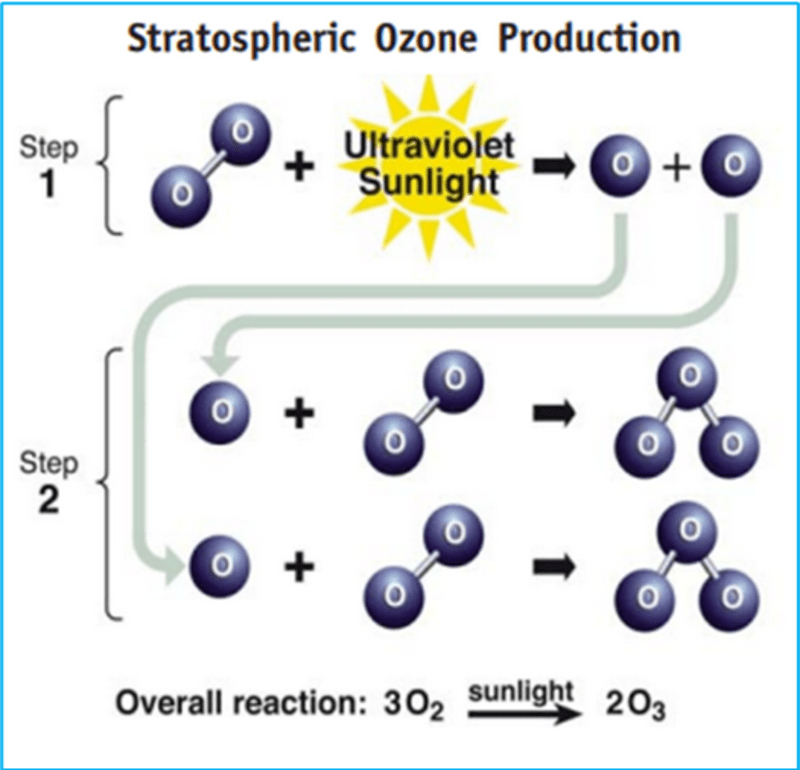
About Ozone Hole:
- Each year, as the Southern Hemisphere’s winter gives way to spring, a temporary thinning occurs in this layer, forming what is known as the "ozone hole."
- Chemicals containing chlorine and bromine atoms combine with certain weather conditions to cause reactions in the ozone layer, leading to ozone molecules being destroyed.
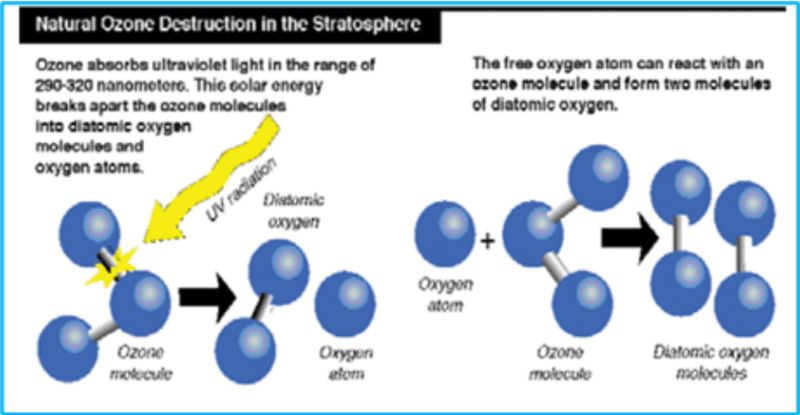
Significance of Ozone Layer:
- This is fundamental to protecting life on Earth’s surface from exposure to harmful levels of this radiation, which can damage and disrupt DNA.
- If ozone molecules are depleted faster than they can be replaced by new ozone molecules that nature produces, the result could be called an ozone deficit.
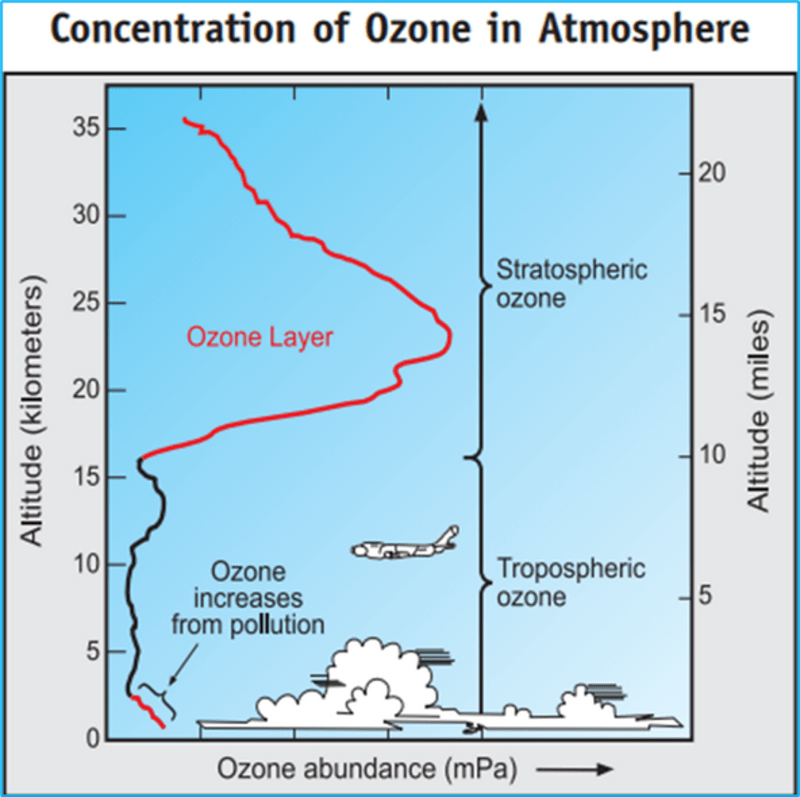
- The depletion of the ozone layer will lead to a reduction of its shielding capacity and, thus, an increased exposure to UV-B radiation.
- The ozone layer absorbs 97% to 99% of the sun’s incoming ultraviolet radiation (UV-B).
-
The ozone layer, often described as Earth’s natural sunscreen, protects the planet from the sun’s ultraviolet rays, which pose dangers such as skin cancer, cataracts, and other health risks.
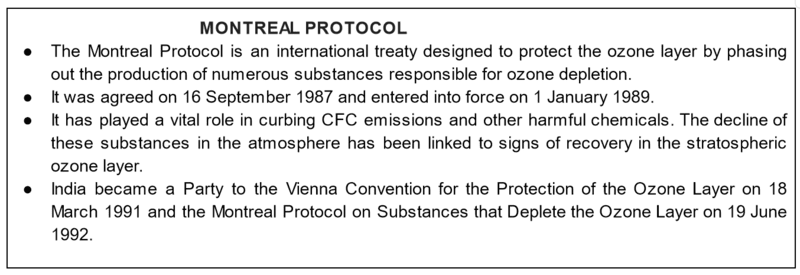
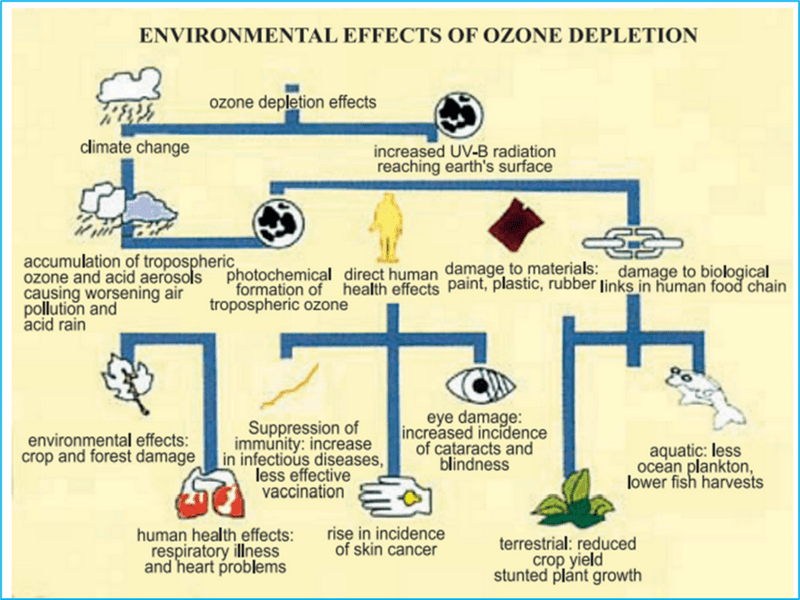
India’s effort for ozone layer conservation:
- India, a Party to the Montreal Protocol since June 1992, has been successfully implementing the Montreal Protocol and its ozone-depleting substances phase-out projects and activities in line with the phase-out schedule of the Protocol.
- India has phased out Chlorofluorocarbons, Carbon tetrachloride, Halons, Methyl Bromide, and Methyl Chloroform for controlled uses as of 1 January 2010, in line with the Montreal Protocol phase-out schedule.
- Currently, Hydrochlorofluorocarbons (HCFCs) are being phased out as per the accelerated schedule of the Montreal Protocol.
- Hydrochlorofluorocarbons Phase-out Management Plan (HPMP) Stage-I has been successfully implemented from 2012 to 2016.
- Hydrochlorofluorocarbons Phase-out Management Plan (HPMP) Stage- II is currently under implementation from 2017 and will be completed by the end of 2024.
- During HPMP Stage-II implementation, India wholly phased out the use of HCFC- 141b in the manufacturing of rigid foam, the first among the developing countries to achieve the milestone.
- As against the target of 35% reduction from the baseline as of 1 January 2020, India achieved a reduction of 44%, highlighting India’s efforts in protecting the stratospheric ozone layer.
- India will complete its phase down of production and consumption of HFCs for controlled uses in 4 steps from 2032 onwards, with a cumulative reduction of 10% in 2032, 20% in 2037, 30% in 2042, and 85% in 2047.
- India ratified the Kigali Amendment to the Montreal Protocol in September 2021. A National Strategy for the down of HFCs in close cooperation with the industry stakeholders shall be developed by 2023.
- To have an integrated long-term vision towards cooling encompassing, inter alia, reducing cooling demand, refrigerant transition, enhancing energy efficiency, and advancing technology options, the MoEFCC developed and launched the India Cooling Action Plan (ICAP) in March 2019.
- MoEFCC has collaborated with 8 Indian Institutes of Technology (Madras, Roorkee, Kanpur Hyderabad, Varanasi, Patna, Kharagpur, and Tirupati) to promote research and development of low global warming potential chemicals, including blends in line with industry requirements through the engagement of research scholars.
Way forward:
- Ozone depletion is a more significant issue and is connected with climate change, so the international community should collaborate the issue of ozone depletion with climate change issues in their agendas.
- People all over the world are still not aware of the importance of the ozone layer. The authorities should control ozone-depleting chemicals’ emissions and warn people not to use such things to emit such chemicals.
- The international community should completely rethink nature and the ozone layer for a better future.
PYQ
Q. The formation of the ozone hole in the Antarctic region has been a cause of concern. What could be the reason for the formation of this hole? UPSC/2011
(a) Presence of prominent tropospheric turbulence; and inflow of chlorofluorocarbons
(b) Presence of prominent polar front and stratospheric': Clouds; and inflow of chlorofluorocarbons
(c) Absence of polar front and stratospheric clouds; and inflow of methane and chlorofluorocarbons
(d) Increased temperature at polar region due to global warming.
Q. How does the melting of the Arctic ice and glaciers of the Antarctic differently affect the weather patterns and human activities on Earth? Explain. UPSC IAS/2021
